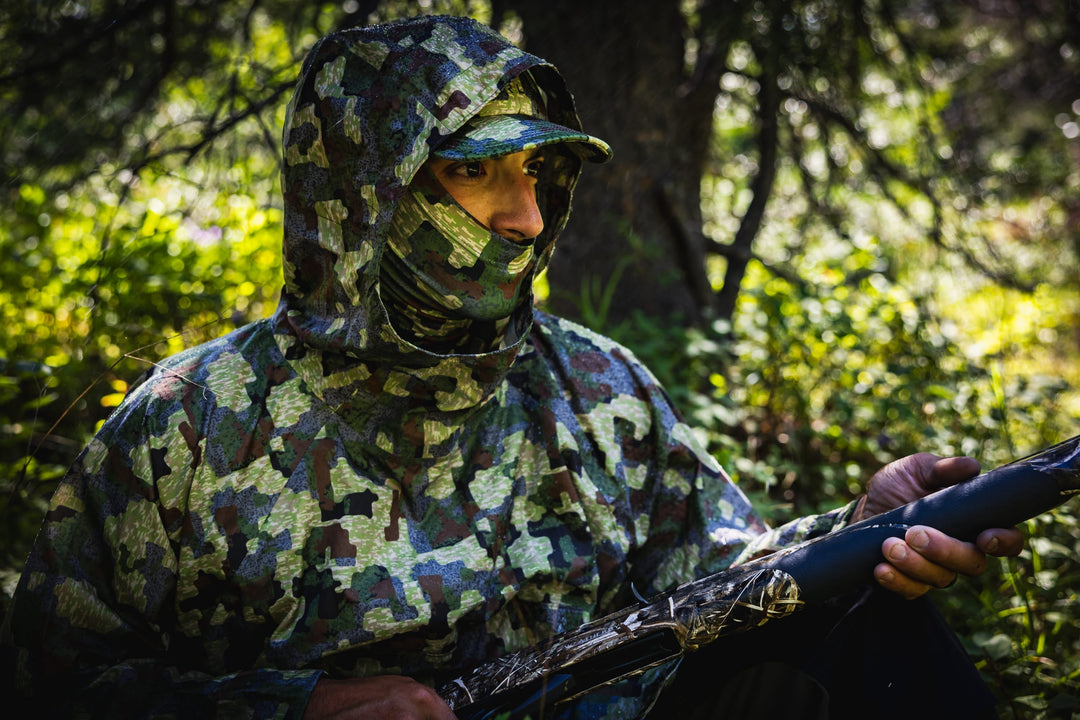From public land to private, early season to late, fully guided to DIY, the options of where and how to hunt can be overwhelming. On a bow hunt in Colorado, we take stock and break it down.
It’s a still, unseasonably warm late-September evening on a 12,000-acre Rocky Mountain ranch at the tail end of Colorado’s Sangre de Cristo range. A pair of bowhunters, including FORLOH owner Andy Techmanski, have been sitting on the fringes of a 9,800-foot meadow all afternoon. They are waiting for the nasal screech of a bull from the dark timber above the clearing, a sign that the animals’ have risen from their beds and might soon emerge. But the only break in the quiet is the occasional sweet trill of the hunters’ cow calls aimed at coaxing down the elk. Daylight fades to the ghostly darkness of the gloaming, and it’s still silent as a morgue.
“Damn elk,” says Mike Barraclough, lead guide on this hunt. Then he adds, “Tomorrow.”
Barraclough never seems stressed nor speaks out of turn, but the slight edge in his voice is telling. It’s night two of a six-day elk hunt smack in the middle of a moonless stretch of typical peak rut dates — what should be prime conditions — and the four hunters and three guides on the property have so far heard little more than the occasional feeble bugle.
Techmanski cut short a public land elk hunt in southern Montana, where the animals were active and his buddy harvested a bull, to travel here for this previously scheduled private-land hunt. The question of whether the trip down will be worthwhile has begun to hover.
There’s a sense among public-land hunters that stalking on swathes of private property is like walking the Promised Land, with animals as abundant as tomatoes on the August vine. So it’s instructive to go from bugling elk on Montana public land to stagnation on a prized ranch in Colorado. No matter where we stalk or how much a tag costs, it’s still always the unpredictable, natural world. That’s why we hunt. On a private land tag, you are more likely to find better habitats and less hunting pressure. Then again, it’s not like big game understands boundaries with OnXMaps clarity.
“As a rule, there are more animals — and better-quality animals — on a private ranch than on public,” says Barraclough, the son of the owner of Raton, New Mexico–based Kiowa Hunting Services. “That’s all subject to unit and season, for sure. But what this land produces versus what you’ll get on the neighboring public is considerably different.” Kiowa has a small, curated range of private land options for hunters, like this elk hunt, but its broad offerings of public-land hunts across New Mexico, Colorado, and Mexico are the company’s bread and butter.
Kiowa has made a name for itself in the Southwest with prodigious success rates on public-land ibex tags in southern New Mexico’s Florida Mountains, one of the most difficult and specialized hunts in the country. They also take above-average numbers of elk, deer, oryx, and other big game throughout the region. “We host every type of hunt you can think of in the places we serve,” says Barraclough. “From semi-guided tags with no accommodation across New Mexico to full-service private ranches throughout the Southwest.”
When choosing a hunt, there are more factors to consider than just cost and the quality of harvestable animals. Barraclough says many hunters use a guide service like Kiowa to increase their odds of hunting, as the outfitter pool is allotted a higher percentage of tags than DIY out-of-state entrants. Also, many private-land hunts are over-the-counter tags, meaning hunters can buy the license, pay the guide fee, and the hunt is guaranteed—an impossibility on public lands. And on hunts like this one in southern Colorado, there’s a ranch house with plush beds, scrumptious food every time you come in from hunting, and a sunny deck to sit on when you’re not in the field. Says Barraclough, “Ranches like this are pretty comfortable. It’s not important to all hunters, but it’s part of what attracts people.”
In Montana, Techmanski was self-supported in the backcountry — tents, food, and carrying if there was a harvest. He came south for the potential. “I’m happy to do the work. That’s the experience,” he says. “The hope here is there’s even more potential.”
On morning three, Barraclough, Techmanski, and crew hunt the dry, piñon and juniper lowlands to the west. Fresh track cuts the dusty, crackly-leafed plains, which are ordinarily damp and quiet from monsoon storms. This year the rains never materialized. It’s fascinating to see how the FORLOH’s Deep Cover camo blends against the trees in the clearings, while the Exposed almost disappears in the wide-open high desert. A bull bugles at first light at the pond below the hunters. After a short stalk and a few locators calls to pinpoint the animal, the team sets up in the rustle of golden aspens to call the bull across. He approaches, promisingly, then goes quiet. Damn elk.
Three more days and nights of sitting wallows and meadows and tree stands ensue. The elk are doing what they do, which doesn’t include walking into clearings in daylight. On this ranch, the dark evergreen is so thick with downed timber and dead leaves crackling like empty candy wrappers underfoot that the primary option for getting in the bow range of an elk is to call and wait. This can be frustrating.
That’s lesson two about picking the hunt: It’s easy to think that all hunts, especially costly ones, are equal. But price doesn’t equate to the style of hunt. Before you book, envision the type of hunt you want — from spot-and-stalk with lots of chasing to horses with wall tents and backcountry camps to sitting still on a blind and bringing them to you. The season and weapon will determine a lot. Kiowa Hunting does it all, with everything from blind hunts in the early season to run-and-gun for those who prefer to chase. Ask in advance so you get the experience you have in your head.
The hunt brings three more quiet nights. Despite the sullen conditions, there are opportunities. A massive bull presents to one hunter at 80 yards on a meadow, but it’s too windy to shoot. Another hunter gets a sleeper shot at 18 yards on a 5x5, but he decides to wait for one of the far bigger bulls in these woods. The third hunter calls a monster to 72 yards, but it’s out of his range.
“You know the difference between a great hunt and a shitty one?” deadpans Barraclough. “Ten seconds.” But even when you don’t get what you want on a hunt, you often walk away with incredible encounters. Bulls blaring face-melting bugles just out of range are nearly as gratifying as a harvest.
Night six, the last hunt, the team heads to a 10,400-foot ridge, where there have been elk sightings but few bugles. No hunter has so far harvested, and spirits are low. Barraclough is undaunted. “Tonight,” he says. “We’re getting it done tonight.”
Early in the evening, the elk are bugling on both sides of the knife-edge ridge. Barraclough calls a herd from the north, but it plows over the saddle like a coal-fired train. Here and gone. Barraclough continues his soft cow calls. The bull circles around. He’s just north of the road now. Techmanski shoots. The huge bull, with an arm’s reach antler spread, goes down. It’s a perfect shot on a perfect elk in the perfect situation. Expectations and hopes, public versus private, lodges or camping—none of it matters once an animal is on the ground. Making those decisions early, however, helps ensure you get the hunt you want.








